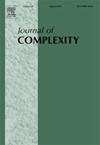非光滑波动方程紧致四阶有限差分格式的误差上限和下限
IF 1.8
2区 数学
Q1 MATHEMATICS
引用次数: 0
摘要
研究了求解一维波动方程的紧凑三阶四阶有限差分格式。对于Sobolev和Nikolskii空间中光滑阶为λ和λ−1的两个初始函数,以及光滑阶为λ−1的自由项,在网格能量范数上用数据证明了分数阶O(h4(λ−1)/5)的新的误差界。并证明了相应的误差下界,以确保上述误差下界相对于每个初始函数和任意λ的自由项的顺序的清晰度。此外,他们还证明,如果误差范数中的Lebesgue可和性指标在x和t中都减弱到1,同时在x和t中数据范数中的可和性指标都增强到∞,则误差上限无法提高。之前已经进行了数值实验,证实了上述阶对半整数λ和分段多项式数据的锐性。本文章由计算机程序翻译,如有差异,请以英文原文为准。
Upper and lower error bounds for a compact fourth-order finite-difference scheme for the wave equation with nonsmooth data
A compact three-level fourth-order finite-difference scheme for solving the 1d wave equation is studied. New error bounds of the fractional order are proved in the mesh energy norm in terms of data, for two initial functions from the Sobolev and Nikolskii spaces with the smoothness orders λ and and the free term with a dominated mixed smoothness of order , for . The corresponding lower error bounds are proved as well to ensure the sharpness in order of the above error bounds with respect to each of the initial functions and the free term for any λ. Moreover, they demonstrate that the upper error bounds cannot be improved if the Lebesgue summability indices in the error norm are weakened down to 1 both in x and t and simultaneously the summability indices in the norms of data are strengthened up to ∞ both in x and t. Numerical experiments confirming the sharpness of the mentioned orders for half-integer λ and piecewise polynomial data have already been carried out previously.
求助全文
通过发布文献求助,成功后即可免费获取论文全文。
去求助
来源期刊

Journal of Complexity
工程技术-计算机:理论方法
CiteScore
3.10
自引率
17.60%
发文量
57
审稿时长
>12 weeks
期刊介绍:
The multidisciplinary Journal of Complexity publishes original research papers that contain substantial mathematical results on complexity as broadly conceived. Outstanding review papers will also be published. In the area of computational complexity, the focus is on complexity over the reals, with the emphasis on lower bounds and optimal algorithms. The Journal of Complexity also publishes articles that provide major new algorithms or make important progress on upper bounds. Other models of computation, such as the Turing machine model, are also of interest. Computational complexity results in a wide variety of areas are solicited.
Areas Include:
• Approximation theory
• Biomedical computing
• Compressed computing and sensing
• Computational finance
• Computational number theory
• Computational stochastics
• Control theory
• Cryptography
• Design of experiments
• Differential equations
• Discrete problems
• Distributed and parallel computation
• High and infinite-dimensional problems
• Information-based complexity
• Inverse and ill-posed problems
• Machine learning
• Markov chain Monte Carlo
• Monte Carlo and quasi-Monte Carlo
• Multivariate integration and approximation
• Noisy data
• Nonlinear and algebraic equations
• Numerical analysis
• Operator equations
• Optimization
• Quantum computing
• Scientific computation
• Tractability of multivariate problems
• Vision and image understanding.
 求助内容:
求助内容: 应助结果提醒方式:
应助结果提醒方式:


